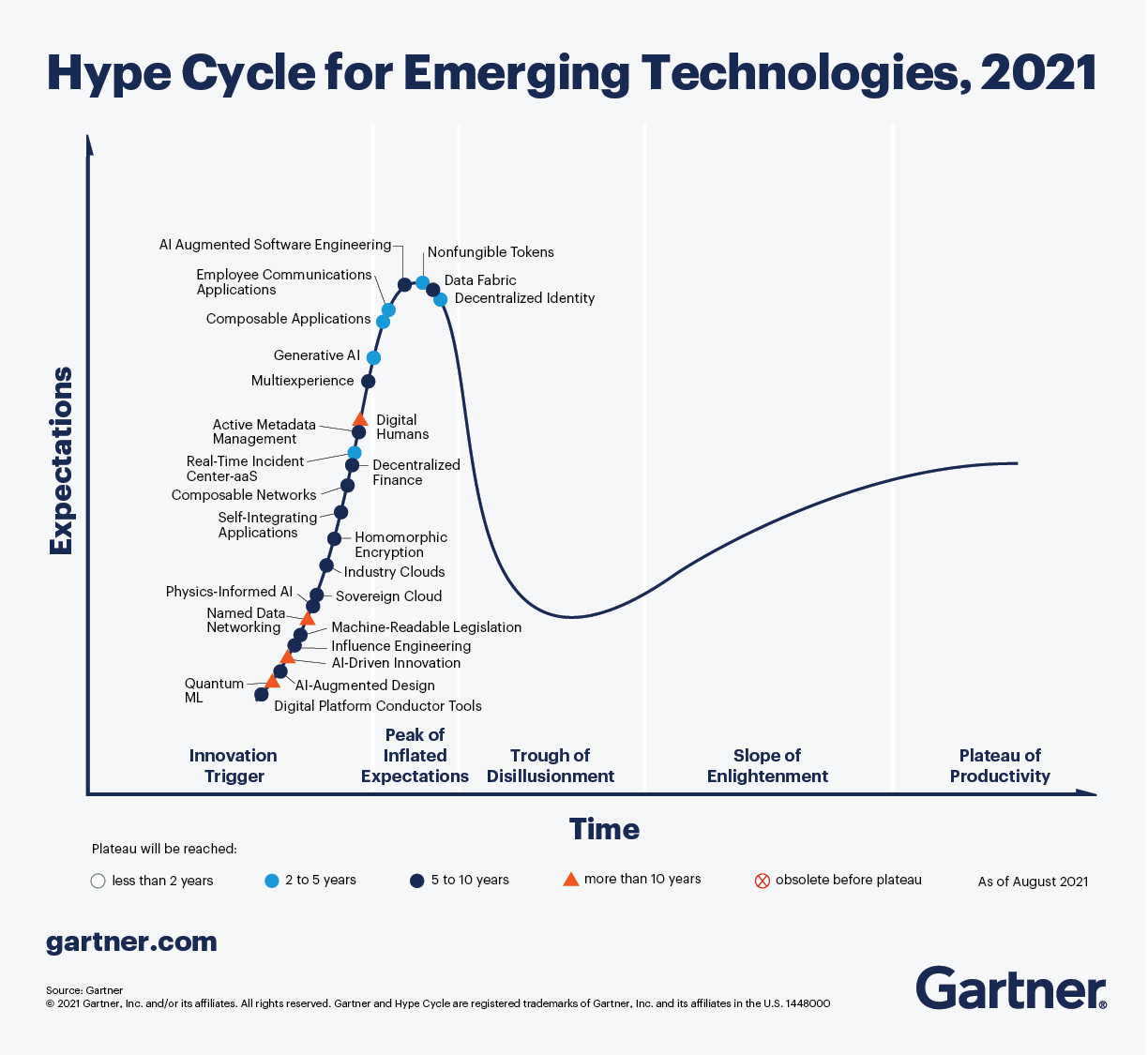3 Themes Surface in the 2021 Hype Cycle for Emerging Technologies

Nonfungible tokens (NFTs), digital humans and physics-informed AI join the 25 technology profiles on this year’s emerging technologies hype cycle.
Earlier this year, Christie’s announced two major firsts for an auction house: It would accept cryptocurrency, and it would offer for sale a purely digital work backed by a unique nonfungible token (NFT).
The work, by digital artist Beeple, sold for more than $69 million. It forms part of an entirely new means of monetization — and potentially a whole new digital ecosystem.
An NFT is a unique blockchain-based digital asset that links to real-world assets like digital art or music and tokenized physical assets like houses or cars. In the case of art, the NFT verifies provenance, ownership and access. NFTs use immutable public blockchains and, as of last month, had a market valuation greater than $300 million.
Download Now: 2020-2022 Emerging Technology Roadmap for Large Enterprises
NFTs are also one of the additions to the Gartner Hype Cycle for Emerging Technologies 2021, which highlights the 25 breakthrough technologies that will have the most significant effect on business and society over the next two to ten years.
Listen Now: Behind the Research: The Gartner Hype Cycle
“Breakthrough technologies are continually appearing, challenging even the most innovative organizations to keep up,” says Brian Burke, Research Vice President, Gartner. “Your focus on digital business transformation means you must accelerate change and cut through the hype surrounding these technologies.”
This year’s technologies, selected for their potential transformational benefits and broad potential impact, fall under three main themes:
- Engineering trust
- Accelerating growth
- Sculpting change

Theme 1: Engineering Trust
For IT teams to effectively lead technology-enabled business transformation, they must engineer a trusted business core. Trust requires security and reliability, but must also be built on working practices that are repeatable, proven, scalable and innovative. These practices establish a resilient core and foundation for IT to deliver business value.
For example, real-time incident command centres as a service improve situational awareness for organizations by fusing together information from various sources. Typically a public safety organization has some more manual way of integrating databases, sensors, video, and communications systems for an emergency command centre.
However, the as-a-service offering simplifies the real-time function of a command centre. Initial interest came from creating next-generation real-time centres to reduce crime. However, use cases have expanded to include wildfire management, natural disasters, special events, and — particularly relevant — pandemic response.
The major challenge with this technology is the required amount of interagency cooperation. All of this data (i.e., databases, radio, IoT, mass notifications, license plate readers and geolocation tracking) is typically owned by separate entities. Nevertheless, real-time incident command centres as a service could improve emergency response.
Read More: Data Fabric Architecture is Key to Modernizing Data Management and Integration
Other technologies in that fall into the engineering trust bucket include sovereign cloud, homomorphic encryption and data fabric.
Theme 2: Accelerating Growth
With a trusted business core in place, you, as IT leaders and CIOs, must focus on initiatives that drive the organization’s growth. That means balancing technology risk with the appetite for business risk, and ensuring that organizational growth targets are near-term and achievable.
Consider digital humans, which are digital-twin representations of people. This technology presents an opportunity for licensed personas that enable new revenue streams. They can appear as avatars, humanoid robots or conversational user interfaces, like chatbots or smart speakers. These interactive, AI-driven representations seem human and behave in “humanlike” ways supported by a range of technologies including conversational UI, CGI and 3D real-time autonomous animation.
Use cases abound for these humanoid technologies in HR training, communications, medical care and customer service. COVID-19 has pushed the technology potential to enable no-touch experiences, combat social isolation and provide care to the elderly. Digital humans have appeared in feature films, performed at conferences and acted as brand influencers. Societal roadblocks and ethical concerns, in addition to immature technologies, create challenges for digital humans, but the potential for business impact and differentiation is pushing some organizations to pursue this technology.
Other emerging technologies that fall under accelerating growth include multi-experience, industry cloud and quantum ML.
Theme 3: Sculpting Change
Change is naturally disruptive. The key is to recognize the disruption and embrace technologies to sculpt the shift and bring order to what otherwise may be chaos. You must anticipate and influence change to mitigate risk.
For example, physics-informed AI (PIAI) is AI that can build physically and scientifically sound AI models. PIAI has garnered particular interest as a more efficient option for modelling complex systems like climate and environmental issues, which are challenging to model given their scale.
Read More: How to Make AI Trustworthy
Traditional digital AI models have limited adaptability because they can’t generalize beyond the data they were trained on. PIAI creates a more reliable representation of the context and physical product. COVID-19 highlighted the vulnerabilities of business models that are too brittle. PIAI creates a more flexible representation of the context and conditions in which systems operate, allowing developers to build more adaptive systems. It can also create more robust and adaptable business simulation systems, which are more reliable for a wider range of scenarios.
Other emerging technologies in this area include composable applications, composable networks and influence engineering.
About Gartner
Gartner, Inc. (NYSE: IT) is the world’s leading research and advisory company and a member of the S&P 500. We equip business leaders with indispensable insights, advice and tools to achieve their mission-critical priorities and build the successful organizations of tomorrow.
Our unmatched combination of expert-led, practitioner-sourced and data-driven research steers clients toward the right decisions on the issues that matter most. We are a trusted advisor and an objective resource for more than 14,000 organizations in more than 100 countries — across all major functions, in every industry and organization size.
To learn more about how we help decision makers fuel the future of business, visit gartner.com.
ลงทะเบียนเข้าสู่ระบบ เพื่ออ่านบทความฟรีไม่จำกัด






